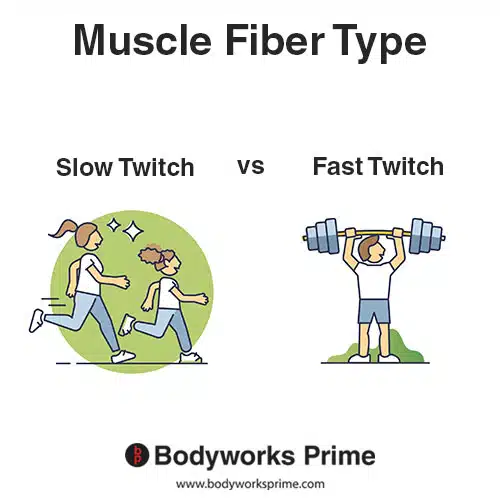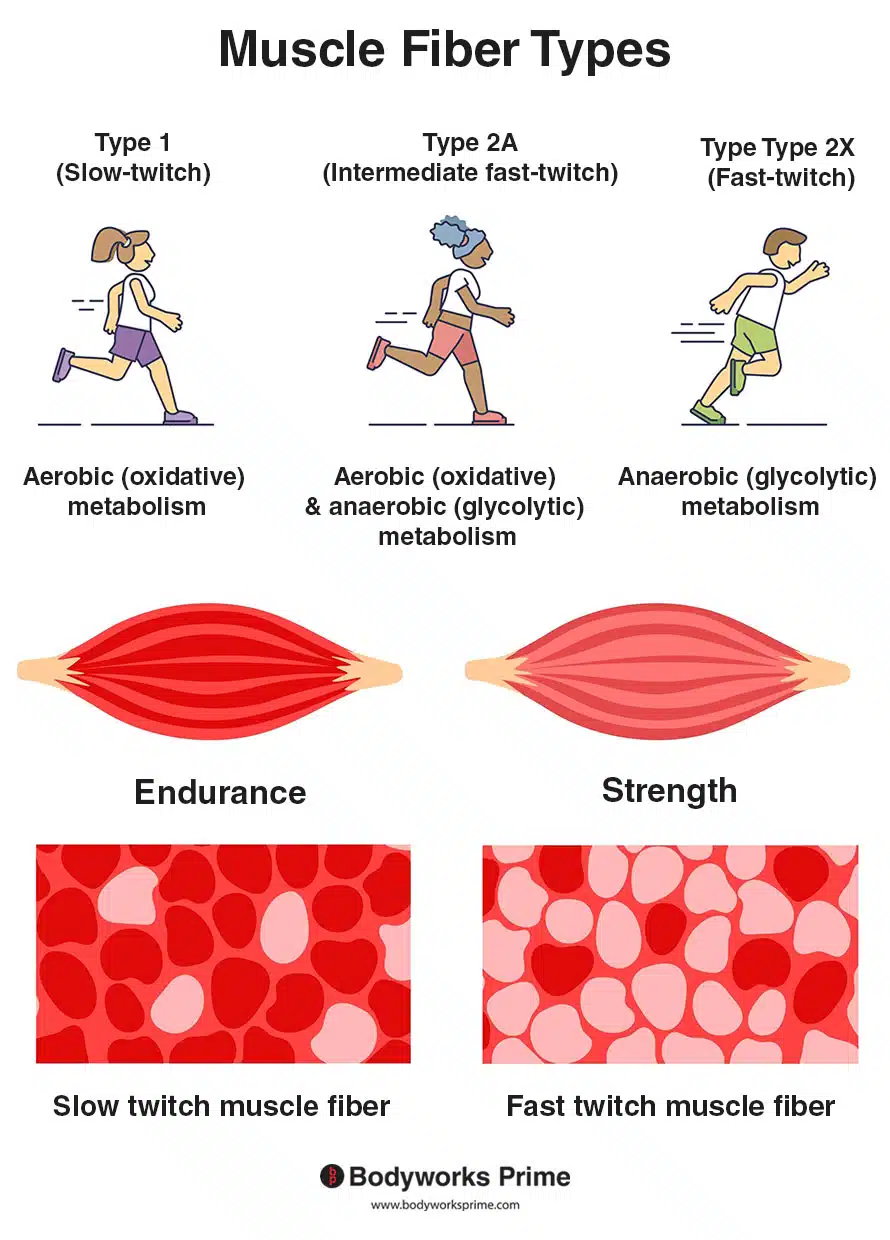The Different Muscle Fiber Types
The human body contains a range of different muscle fiber types, each is adapted to perform specific functions and respond to different types of physical demands. These muscle fibers are categorised based on their contraction speed, fatigue resistance, metabolic characteristics, and other intrinsic properties. The types of muscle fibers are outlined below:

Type 1 fibers (Slow-twitch fibers)
Type 1 muscle fibers, commonly referred to as slow-twitch fibers, possess a high capacity for oxidative metabolism. This means they primarily use oxygen to produce energy. They have a rich supply of mitochondria, the cellular powerhouses, and an abundant amount of myoglobin, which gives these fibers their characteristic red color. The presence of numerous blood vessels ensures a steady supply of oxygen. Due to these features, Type 1 fibers are fatigue-resistant and can sustain activity for prolonged periods. They are predominantly engaged in endurance activities like long-distance running, where strength is less of a priority but endurance is crucial.
Type 2A fibers (Intermediate fast-twitch fibers)
Type 2A fibers serve as a bridge between the slow-twitch Type 1 fibers and the more rapid Type 2X fibers. They have a faster contraction speed compared to Type 1 fibers and can use both aerobic (oxidative) and anaerobic (glycolytic) metabolism to generate energy. This duality allows them to be versatile, supporting activities of moderate intensity that require a balance of strength and endurance. They contain a moderate amount of mitochondria and myoglobin, rendering them less resistant to fatigue than Type 1 fibers but more so than Type 2X fibers. Activities that utilise Type 2A fibers include middle-distance running or swimming, where both speed and stamina play a role. Moderate intensity resistance training, with repetition ranges on the higher end of the spectrum, is another example of a type 2A dominant activity (an example would be a stereotypical bodybuilding style workout using the 12-15 repetition range or intensifiers such as drop sets).
Type 2X (Fast-twitch fibers)
The Type 2X fibers are fast-twitch fibers which are designed for quick and powerful bursts of activity. They rely predominantly on anaerobic glycolytic metabolism, which means they produce energy without using oxygen but do so in shorter bursts. They are generally far less abundant within the muscle than type 2A and type 1 fibers. These fibers contain fewer mitochondria and less myoglobin than these other fiber types also, making them more pale in color. While they can generate high force outputs, they fatigue relatively quickly. They are primarily activated during high-intensity, short-duration activities like sprinting or olympic weightlifting, where rapid, forceful contractions are needed.

What About Type 2B & Type 2C Muscle Fibers?
In the past, researchers based their understanding of muscle fiber types on animal studies, leading to the identification of type 2B and type 2C fibers. However, these terms have since been deemed irrelevant and outdated for human muscle fiber classification because they were based on assumptions that didn’t necessarily apply to humans. In modern understanding, there are three primary muscle fiber categories in humans: Type 1, Type 2A, and Type 2X.
Comparing Muscle Fibers Types
The table below offers a side-by-side comparison of each muscle fiber type’s different properties. This table will allow you to quickly identify the specific characteristics and performance capabilities of Type 1, Type 2A, and Type 2X fibers.
| Qualities | Type 1 Fibers | Type 2A Fibers | Type 2X Fibers |
|---|---|---|---|
| Contraction Speed (Twitch Speed) | Slow | Intermediate | Fast |
| Fatigue Resistance (Endurance) | High | Moderate | Low |
| Oxidative Capacity (Aerobic Capacity) | High | Moderate | Low |
| Anaerobic Capacity (Glycolytic Capacity) | Low | High | Very High |
| Mitochondrial Density (Energy Production Centers) | High | Moderate | Low |
| Myoglobin Content (Oxygen Storage) | High | Moderate | Low |
| Blood Vessel Supply (Oxygen Delivery) | High | Moderate | Low |
| Color (Due to Myoglobin Content) | Red | Pinkish-Red | Pale |
| Preferred Energy Pathway (Metabolism Type) | Aerobic | Mixed | Anaerobic |
| Activity Suitability (Typical Use Cases) | Endurance | Mixed Duration | Short Bursts |
| Resistance to Fatigue (Sustainability of Contraction) | High | Moderate | Low |
Should You Train Based on Your Muscle Fiber Type?
Understanding muscle fiber types provides valuable insights into human physiology, but how should one translate this knowledge into real-world training? Here are some practical considerations:
Determining Muscle Fiber Type
There’s no foolproof method to pinpoint your exact muscle fiber type. While some trainers promote tests based on reps and weights to classify fiber types, these are largely unreliable. Such tests mainly reveal an athlete’s current training adaptations. For instance, endurance training will enhance high-rep performance, while strength training will improve low-rep capacity. If an athlete shifts their training focus, their proficiency in the new way of training will improve accordingly.
Variability of Fiber Types
Muscle fiber composition is not uniform across different muscles, nor between individuals. Even within a single muscle, the fiber type can differ. A biopsy of a tiny muscle segment won’t give a comprehensive view of one’s overall fiber distribution. For instance, taking a biopsy a few millimeters away could yield a different fiber type.
Practical Application
In essence, it’s virtually impossible for the average person to accurately determine their dominant muscle fiber type. Claims that pigeonhole someone into a specific category and dictate a training regime based on that are often misguided. However, there are some general observations:
Fast Twitch Considerations: Individuals with a dominance of fast-twitch fibers may experience increased muscle damage from resistance training, largely due to the fact that fast-twitch fibers have a reduced defence against calcium ions (due to their glycolytic nature). Fast-twitch dominant individuals might need longer rest periods between sets to maintain performance, and additional rest days between sessions to fully recover, given the enhanced disruption and damage induced by these calcium ions. Nevertheless, the total recovery duration can vary based on factors like workout volume, intensity, stress, nutritional and recovery status, genetics, and more. Therefore, the best method to determine ideal training volume and frequency involves a systematic approach of trial and error, starting your training plan with low volume and frequency and building up, adjusting only one variable at a time. No universal blueprint exists for the optimal approach; it’s unique to each individual. There’s no one-size-fits-all formula of sets x reps x frequency that guarantees rapid muscle growth or performance for everyone. Through tracking progress and monitoring bodily feedback, individuals will realise that some people flourish with frequent training, while others may even lose muscle or performance from overly frequent sessions, necessitating more rest days and reduced session volume. Fiber type is just one factor influencing this variability in training adaptations. Considering there are numerous other individual and genetic factors to consider, which we have little way to easily determine with present technology (or it is just too expensive for the average person to access), this makes tailoring training purely based on speculative fiber type assumptions rather impractical and a waste of time.
The Real Key: The debate on muscle fiber types often distracts from the essence of effective training, which is consistent monitoring and ajustments based on real world results. Foundational principles, like progressive overload, remain vital. However, factors with high individual variability, like training volume and frequency, demand a personalised approach. Start with a moderate regime, diligently track progress, and adjust one parameter at a time based on outcomes. Over-complicating training by agonising over muscle fiber type is unnecessary. Focus on what’s demonstrably effective through consistent documentation and adjustment.










